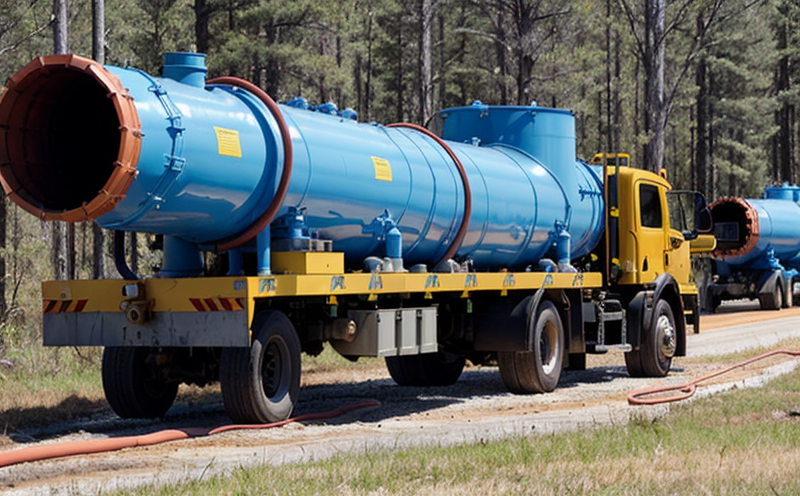ASME B31.8 Gas Transmission and Distribution Piping System Testing
The ASME B31.8 standard governs the design, construction, operation, and maintenance of gas transmission and distribution piping systems. This service focuses on ensuring these critical infrastructure components meet stringent safety standards through comprehensive testing procedures.
Our laboratory adheres to rigorous methodologies that align with industry best practices outlined in ASME B31.8-2016. These tests encompass hydrostatic pressure testing, leakage detection, visual inspections, and other assessments necessary for compliance with local regulations and international standards.
For instance, during a typical test sequence, we begin by inspecting the piping system's design plans against ASME B31.8 requirements. This includes verifying wall thicknesses, material specifications, weld quality, and overall structural integrity. Once these checks are complete, we proceed with pressure testing under controlled conditions to simulate real-world operating pressures.
Leak detection is another crucial step where specialized equipment is used to identify any potential leaks within the system. Our team employs advanced technology such as tracer gas testing or ultrasonic leak detectors to ensure no hidden vulnerabilities exist post-installation. Visual inspections complement these technical assessments by allowing our experts to spot surface defects that might compromise safety.
In addition to routine tests, our services also cover specialized scenarios like after-repair evaluations following maintenance activities or modifications to existing systems. These additional checks help maintain consistent performance levels throughout the lifecycle of a piping network while ensuring any necessary adjustments are made promptly.
By adhering strictly to ASME B31.8 guidelines, we provide clients with peace-of-mind knowing their facilities comply with regulatory requirements and industry benchmarks. This ensures not only regulatory compliance but also enhanced operational efficiency and reduced risk of costly failures or accidents.
Scope and Methodology
The scope of ASME B31.8 Gas Transmission and Distribution Piping System Testing includes a comprehensive suite of services designed to verify the integrity, safety, and compliance of natural gas distribution networks with relevant standards.
- Hydrostatic Pressure Testing: This involves subjecting pipes or fittings to specified pressures to check for structural soundness.
- Leak Detection: Utilizing advanced techniques like tracer gas testing to detect even minute leaks that could pose risks.
- Visual Inspections: Conducted by trained professionals who examine the visible aspects of piping systems for signs of wear or damage.
The methodology employed is based on strict adherence to ASME B31.8-2016, ensuring that every aspect of the testing process adheres to established protocols. Compliance with these standards not only guarantees operational safety but also supports long-term reliability and sustainability of natural gas distribution systems.
Industry Applications
- Utility Companies: Regular testing ensures that gas pipelines operate efficiently without compromising on safety standards.
- Construction Firms: Before commissioning new installations, thorough inspections are conducted to prevent any potential hazards during usage.
- Government Agencies: Regulatory bodies often mandate periodic checks to maintain public safety and environmental protection.
- Industrial Facilities: Many industrial plants rely on natural gas for heating or power generation, making regular testing essential.
Incorporating these services into daily operations helps businesses stay ahead of regulatory changes while minimizing downtime due to unforeseen issues. By investing in proactive maintenance practices through our specialized testing solutions, organizations can enhance their reputation as reliable partners and contributors to sustainable development efforts.
Competitive Advantage and Market Impact
In today's competitive landscape, ensuring compliance with ASME B31.8 standards is not just a requirement but also a strategic differentiator for utilities and pipeline operators. By offering these testing services, we help our clients achieve several key advantages:
- Enhanced Safety: Our rigorous testing protocols minimize risks associated with gas leaks or failures.
- Risk Mitigation: Early identification of potential problems allows for timely interventions before they escalate into larger issues.
- Regulatory Compliance: Ensuring adherence to ASME B31.8 helps avoid costly fines and penalties.
- Client Satisfaction: Reliable performance translates directly into higher customer trust and loyalty.
The market impact of these services extends beyond individual companies; they contribute significantly towards fostering a safer environment for all users of natural gas. As such, our offerings play a pivotal role in shaping industry trends and practices globally.





